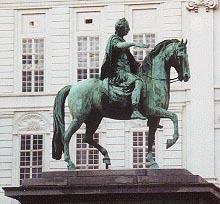These magnificant white horses have dazzled the equestrian world for centuries.
Decending from the noble Andalusian and the hardy Arabian, Lipizzaners were favored mounts of Austrian nobility and aristocracy. The stallions exeptional strength and agility made them exelent mounts for calvary. Trained by expert horsemen the horses great leaps and caprioles struck fear into the hearts of enemy foot soldiers. The mares gentle beuty and high intellegence made them desired coach horses and mounts for the elite.
In 1580 Arch Duke Karl established a royal stud farm in lipizzawhere spanish bloodlines were added to maintain the breeds strength
In 1781 300 horses were evacuated from Austria during the Napoleonic wars and were returned to Lipizza when the threat was over, only to be evacuated one again in 1805 and yet again shortly thereafter when advancing French armies threatened.
In 1915 the Lipizzans were split in two groups, some were sent to Vienna and others to Kladrub.
In 1918 Lipizza became a part of Italy and the horses were devided again by the Austrian and Italian governments.
The Austrian horses went to Piber stud farm in Steiermark where they were used as calvary mounts and bred to produce a lighter strain of the breed.
In 1945 the noble Lipizzan once again needed to be rescued from the threat of war. This time the 42nd squadron of the United States Army's 2nd calvary would come to their rescue Commanded by general George S. patton the 42nd squadron protected the horses as starving refugees of war ravaged Austria tried to steal the horses for food. During this time the mares and foals were being held at the German remount depot in Hostau ,while the stallions were in St.Martins in upper Austria.The 42nd squadron attacked the German lines on April 28 and rescued 150 Lipizzaners and allied troops. The horses were then inspected and returned to their home.
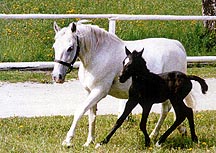
Lipizzaners generaly live to 35 years of age, 10 years longer than most breeds.
They are born black and gradually lighten over a period of 6-10 years , untill they are pure white. Very rarely is a Lipizzan born white.
There are 6 major Lipizzaner bloodlines origionating and dating back to the following stallions.
The Dane "Pluto" 1765
The Neapolitan,"Conversano" 1767
"Maestosa"1773
"Favory," 1799
"Neapolitano," 1790
and the Arabian,"Siglavy" 1810Lipizzaners are the worlds most branded horse( brand photos from the spanish riding school of vienna). Most carry 4 brands, a small letter "L" on the left cheek as a representation of the breed this is called the brand of decent.
3 symbols on the left side of the back usually hidden by a saddle. These represent the bloodlines of the horses Sire and Dam also known as the Ancestral brand .The letter indicates the father and the symbol below it is the mother after the fathers letter is the breeed number .the s in this photo represents the stallion Siglavy the sideways cross is for the mares lineage in this case Neapolitano and the number 4 is the breed number ie) this horses name would start siglavyIV with a chosen suffex
symbols for the mares lineage are as followsConversano
Favory
Maestoso
Neapolitano
Pluto
Siglavy
there is also a brand of a number on the right side of the back usualy hidden by the saddle, this is the foal registry brand .

And on the left haunch a brand from the stud farm where the horse was foaled
.this is the brand of the Piber stud farm

Lipizzaners have been made famouse for their performance of "Airs above ground"origionaly these feets of strength and agility were used in times of war rendering the rider virtually untouchable.In modern times these feets are used to amaze and mystify audiances around the world,as the white stallions leap and dance to classical music. Only stallions with exeptional strength, talent and athletic ability are chosen to preform these ancient maneuvers and each stallion is taught only one or two of these movements during its lifetime.The Capriole
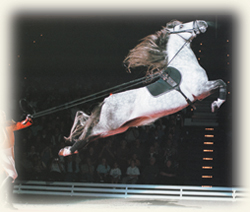
The horse leaps high into the air and pulls his forelegs under his chest. he then kicks violently outward with his hind legsCourbette
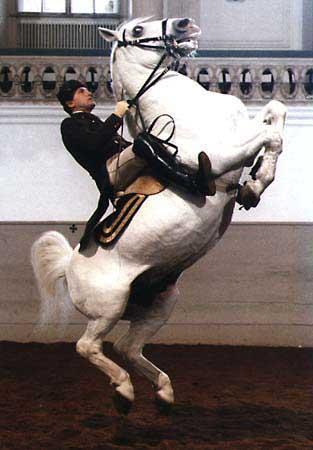
The stallion rears up onto his hind legs then leaps into the air keeping his hind legs togetherCroupade
( photos of the croupade are exremely difficult to find)
Similar to the Capriole
but instead of kicking back with his hind legs he tucks both fore and hind lega beneith his bodyLevade
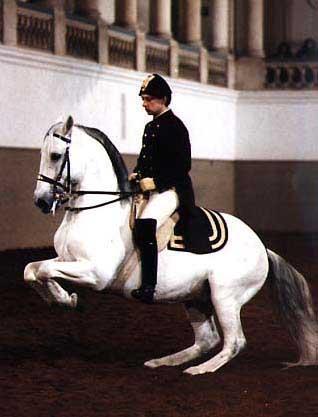
The stallion rears up at a 45 degree angle tucking his forelegs close to his body and holding this position for several seconds. This maneuver requires exeptional strength and balancePiaffe


The stallion trotts in place.Pirouette
The stallion rears up onto his hind legs and pivots either a half or full circle before placing all four feet on the groundThese amazing stallions and their talented riders put on a truly spectacular show. I highly reccomend taking in the show should you have the opportunity to watch them perform in your area, it is surely a most memorable event.
LINKS
